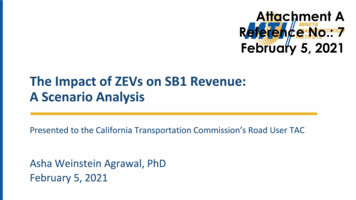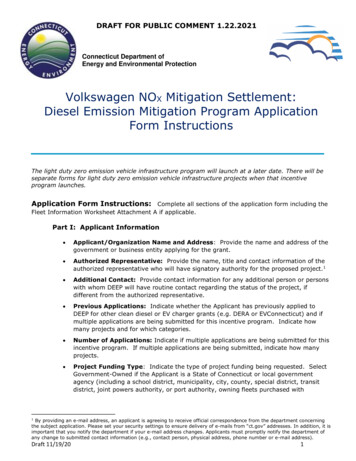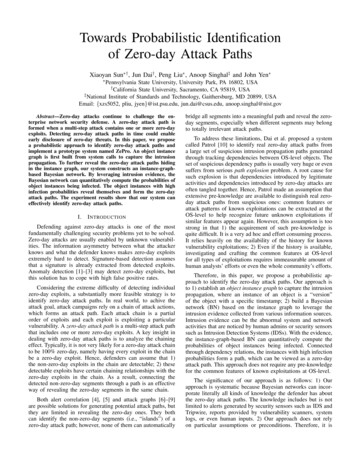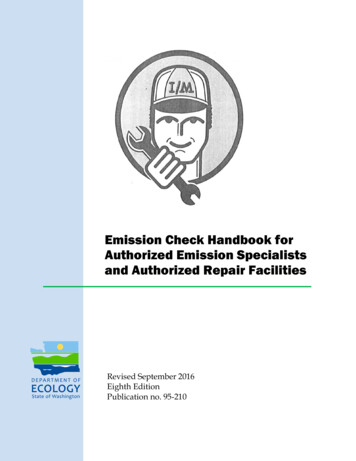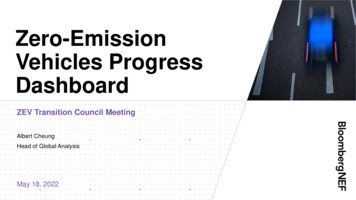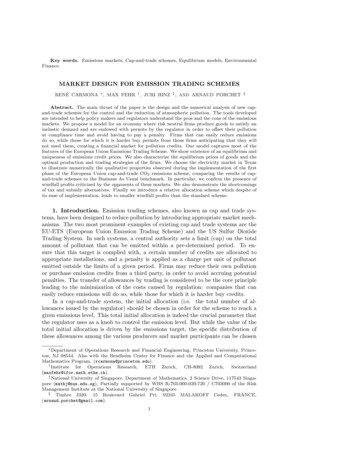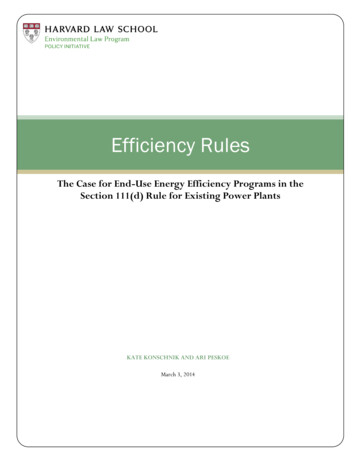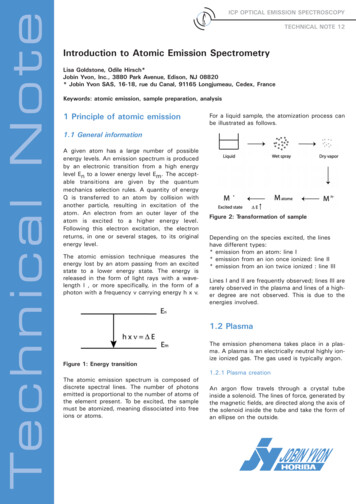
Transcription
ZERO EMISSION VEHICLES (ZEVs):TOWARDS A POLICY FRAMEWORK
AUTHORS & ACKNOWLEDGEMENTSAUTHORSACKNOWLEDGEMENTSNITI AayogThe authors would like to thankDr. Rajiv Kumar, Vice Chairman, NITIAayog and Mr. Amitabh Kant, CEO, NITIAayog for their support that made thisreport possible.Shikha JuyalHarkiran SanjeeviAbhishek SaxenaShweta SharmaAakaash SinghWorld Energy CouncilSeethapathy ChanderIndependent ContributorSUGGESTED CITATIONSNITI Aayog & World Energy Council.Zero Emission Vehicles (ZEVs):Towards a Policy Framework, 2018Ashok JhunjhunwalaCONTACTSNITI Aayog, adv.niti@gov.in, http://niti.gov.in/World Energy Council, info@wecindia.in,wecindia.inThe views & opinions expressed in this document arethose of the authors and do not necessarily reflect thepositions of the institutions or governments. Whileevery effort has been made to verify the data andinformation contained in this report, any mistakes andomissions are attributed solely to the authors and notto the organization they represent.
TABLE OF CONTENTSI.THE GLOBAL CONTEXT3II.THE INDIAN CONTEXT3III.CUSTOMIZING INDIA’S EV POLICY TO THE INDIAN AUTO-INDUSTRY TODAY4IV.MAKING EVs ECONOMICALLY VIABLE5V.“MAKE IN INDIA” - IMPORT DUTY AND TAXES6VI.POLICY FOR CHARGING / SWAPPING INFRASTRUCTURE7VII.BATTERY CELLS, PACKS AND MATERIALS8VIII.FOCUS ON SMALL AND PUBLIC VEHICLES TO MAKE EARLY IMPACT9IX.RESEARCH AND DEVELOPMENT AND TECHNOLOGY WATCH9X.TRANSFORMING AUTO-ANCILLARIES: A FOCUS ON POWER-ELECTRONICSINDUSTRY AND ELECTRICITY DISTRIBUTION SYSTEM / IMPACT ON THE GRID9XI.IMPACT OF EVs ON ECONOMIC GROWTH AND EMPLOYMENT10XII.CONCLUSION11APPENDIX I:BATTERY SPECIFICSAPPENDIX II: DRIVE TRAINS1214
I.THE GLOBAL CONTEXTHistorically, mobility and fossil fuels have been inextricably linked with electric vehicles beingsuccessful only in a few niche markets. However, over the last decade, a collection ofcircumstances have conspired to create an opening for electric mobility to enter the massmarket. Those forces include:1. Climatic change: The prospect of rapid global temperature increase has created the needfor a reduction in the use of fossil fuels and the associated emissions. India has committedto cutting its GHG emissions intensity by 33% to 35% percent below 2005 levels by 2030.2. Advances in renewable energy: Over the last decade, advances in wind and solarelectricity generation technologies have drastically reduced their cost and introduced thepossibility of clean, low-carbon and inexpensive grids. India proposes to add 175 GW ofrenewable energy capacity by 2020 and to achieve 40 percent of its electricity generationfrom non-fossil sources by the same year.3. Rapid urbanization: Economic development, especially in emerging economies, is creatinga wave of urbanization as rural populations move to cities in search of employment. Whileurbanization is an important component of the process of economic development, it alsostresses upon the energy and transport infrastructure leading to congestion and pollution.According to a recent study by WHO, India is home to 14 out of 20 most polluted cities inthe world. Electric vehicles (EVs) can improve that scenario by reducing localconcentrations of pollutants in cities.4. Data capture and analysis: With the rise of GPS enabled smartphones and the associateduniverse of mobility applications, mobility has undergone a digital revolution. That digitalrevolution has created possibility of a greater utilization of existing transportation assetsand infrastructure. For EVs, which rely on lower variable costs to offset relatively high fixedcosts, this enhanced utilization is a critical element of achieving total costs of ownershipcompared to internal combustion vehicles.5. Battery chemistry: Advances in battery technology have led to higher energy densities,faster charging and reduced battery degradation from charging. Combined with thedevelopment of motors with higher rating and reliability, these improvements in batterychemistry have reduced costs and improved the performance and efficiency of electricvehicles.6. Energy security: The petrol, diesel and CNG needed to fuel an internal combustion engine(ICE) based mobility system requires an extensive costly supply chain that is prone todisruption from weather, geopolitical events and other factors. India needs to import oil tocover over 80 percent of its transport fuel. That ratio is set to grow as a rapidly urbanizingpopulation demands greater intra-city and inter-city mobility.As a result, developed economies such as EU, the USA and Japan as well as developingeconomies such as China and India have all included EVs in their policies to lower theircarbon emissions while providing convenient and cost-effective mobility.II.THE INDIAN CONTEXTWhile many countries have included EVs as an element of transportation policy, theirresponses have varied according to their stage of economic development, energy resourceendowments, technological capabilities, and political prioritization of responses to climatechange. In India, a particular set of circumstances which are conducive to a sustainablemobility paradigm have created an opportunity for accelerated adoption of EVs over ICE3
vehicles. These are:1. A relative abundance of exploitable renewable energy resources.2. High availability of skilled manpower and technology in manufacturing and IT software.3. An infrastructure and consumer transition that affords opportunities to apply technologiesto leapfrog stages of development.4. A universal culture that accepts and promotes sharing of assets and resources for theoverall common good.These circumstances position India to pursue an EV policy which systematically ensures thatIndia’s EV program keeps pace with the global scale since large economies seem to takesignificant steps towards electrification of vehicles. India’s growth prospects create potentialfor developing leadership in EV in certain segments. In that sense, the policy will encouragea path which starts with India-specific characteristics and initiatives for its auto sector,building towards global relevance and applications. The key objectives of the EV policy are:1. Reduce primary oil consumption in transportation.2. Facilitate customer adoption of electric and clean energy vehicles.3. Encourage cutting edge technology in India through adoption, adaptation, and researchand development.4. Improve transportation used by the common man for personal and goods transportation.5. Reduce pollution in cities.6. Create EV manufacturing capacity that is of global scale and competitiveness.7. Facilitate employment growth in a sun-rise sector.III. CUSTOMIZING INDIA’S EV POLICY TO THEINDIAN AUTO-INDUSTRY TODAYWhile India is operating in the same global context as other countries who have adopted anEV policy, it has a unique mobility pattern which other countries do not share. An EV policyfor India must be tailor made to India’s particular needs. While vehicle growth in India is rapid,ownership per 1000 population has increased from 53 in 2001 to 167 in 2015,[1] a keydifference between India and other countries and the types of vehicles being used. Indiauses a large variety of motorized transport on roads and its auto-segments are quite differentfrom that of most of the world. Based on the last six years of sales data, the vehicles onIndian roads are estimated to consist of:1. Two-wheelers: 79% of the total number of vehicles.2. Three-wheelers (passenger and goods), including tempos: 4% of the total number ofvehicles.3. Buses and large goods vehicles like trucks: 3% of the total number of vehicles.4. Economy four-wheelers (cars costing less than 1 million): 12% of the total number ofvehicles.5. Premium four-wheelers (cars costing higher than 1 million): 2% of the total number ofvehicles.In India, premium four wheelers (cars) are only 2% of the total sales. However, mostadvanced technologies are available in this category in global markets. In the near term, India4
should foster early adoption of vehicles by premium customers which will pave the way forconsumer comfort with electrification, raise aspirations for indigenous products and makeadvanced technology available in the market. The presence of world-class technology willhelp India build a world-class ecosystem for high-quality component and subsystems usablefor all kinds of vehicles.In the longer term, India should establish technological and manufacturing leadership in theeconomy segment of the market. The prevalence in India of small vehicles such astwo-wheelers, three-wheelers, economy four-wheelers and small goods vehicles is uniqueamong large countries. These small vehicles require a unique set of technological andindustrial capabilities. Here, India has an opportunity to take a leadership role in theelectrification of small vehicles. India’s potential volumes for these vehicles as the nationgrows, lays the foundation for transformational manufacturing and industrial policy. Thatfocusses on the development of technological expertise and industrial capabilities in theproduction of small electric vehicles which can not only meet domestic demand but can alsoplace India in a position of global leadership. As other countries begin to look at smallervehicles with appropriate specifications, India can establish a position of leadership basedon domestic demand.Beyond significant domestic demand for smaller vehicles, another aspect of the Indianmobility market is supportive of electrification: its high level of sharing. Shared mobility inIndia has exploded, changing the way India travels. Taxi aggregators such as Ola and Uberincreases from 130 million rides in 2015 to 500 million rides in 2016[2], leading radio taxis toaccount for 72% of the overall market. This high penetration of shared mobility in Indiaincreases both vehicle utilisation, which plays to the economic advantages of EVs, and alsocreates natural and large-scale purchases of EVs.IV.MAKING EVS ECONOMICALLY VIABLEThe limiting factor of batteries on driving range may be addressed by developing anecosystem of fast-charging or swapping of batteries. This can be achieved by creatingrequisite infrastructure, possibly even every kilometer, in dense areas. As a result animportant question arises as to what kind of strategy can make EVs, especially smallvehicles, economically viable. The general strategy should address two key variablesaffecting the costs of EVs: battery costs and any fiscal policies that either increase the costsof an ICE vehicle or decrease the costs of an EV.Broadly speaking, approaches exist to reduce battery costs – reducing the number ofbatteries that an electric vehicle needs and making batteries cheaper on a per kilowatt-hourbasis. For the first approach, reducing the batteries needed for a given EV, there are two keypathways:1. Providing charging infrastructure: The limiting factor of batteries on driving range maybe addressed by developing an ecosystem of fast-charging or swapping of batteries, bycreating an infrastructure, maybe even every kilometre, in dense areas. A smaller batterywill lower costs by reducing the total weight of the vehicle, resulting in higherenergy-efficiency and improved ability to upgrade as the technology evolves. Charginginfrastructure can be rolled out on a city by city basis with select cities and regions leadingthe transition. This would be consistent with global experience where 33 percent of all EVsales take place in only 14 cities where charging infrastructure is widespread andconvenient to use. Approaches for creating effective charging infrastructure are outlinedbelow.2. Increasing efficiency of vehicles: Incentivising developments to increase vehicle5
efficiency, thereby reducing energy consumption, can enable to a vehicle to travel thesame distance on a smaller battery pack. Energy efficiency can be enhanced by usingmore efficient electric motors [see Appendix II] using better tyres, enhancing the aerodynamics of the vehicles and reducing its weight. This would reduce battery size neededfor a certain range.For the second approach, reducing the unit costs of each battery, India can explore severalpathways:a. Selecting appropriate battery chemistries [See Appendix I]: As batteries dominate costsof electric vehicles, the strategy would be to use battery chemistry with optimized cost andperformance at Indian temperatures. India should encourage manufacturing of suchbattery cells in India. India is already making battery packs (cell to pack).b. Exploring new battery chemistries: Focussing on materials like lithium, manganese,nickle, cobalt and graphite that are used in batteries and determine its costs. While it isimportant to secure mines which produce these materials, India must also obtain thesebattery materials through recycling of used batteries and should aim to become the capitalof “urban mining” of used batteries.Beyond reducing battery costs, India can explore potential avenues of fiscal support for EVsto accelerate adoption. The standard approach in other countries to providing fiscal supportto EVs has been direct subsidization. For example, EVs in USA, Europe and China have upto[3] 40% “all-in” subsidies. Those subsidies include direct federal or state subsidy to buyers,mandates to manufacturers, utility subsidies or subsidy in the form of fee bates wherevehicles are taxed based on their CO2 emissions, whereas EV receives support. As costsdecline and the share of EVs in total vehicles increases, most nations plan to taper off suchsubsidies.For India, however, those paths are not viable; the elimination of direct subsidy will be thepolicy basis. Therefore India has to be creative to make electric vehicles and its infrastructureeconomically viable from the very beginning. Its policy and strategy have to be fundamentallyset up to enable EVs to make business sense. Direct financial demand-incentives / subsidiescould be replaced by Tradable Auto-Emission Coupons or credits based on CO2 emissionsper km as well as on a sliding scale for vehicle efficiency. This will encourage the market tobuild efficient vehicles with lower emissions per km. Thus, while vehicle manufacturersexceeding CO2 emissions targets would have to purchase coupons or credits, themanufacturers meeting the targets would be rewarded with coupons. Market will decide theprices of these coupons. This will incentivize EVs and low-emission vehicles as well asenergy-efficient vehicles at the expense of the vehicles with high emissions andlower-efficiency.Accelerating the availability of necessary electricity network infrastructure as well asdomestically produced technologically superior EVs, chargers and components will bringdown costs and increase the options available for transportation electrification in India. Thiscould bring total cost of ownership (TCO) of EVs to parity with ICEs by as early as 2025.V.“MAKE IN INDIA” - IMPORT DUTY AND TAXESIMPORT DUTY AND MAKE IN INDIA1. Keeping in mind the stage of EVs in the country, India needs a new approach to import dutywhile keeping “Make in India” as a goal. The principle of establishing custom duties will beto give specific preference to value chains manufactured in India. Goods contributing tothe lowest value-add chain (like finished goods) would have the highest import duty; one6
contributing higher value-add (like components) would have lower import duty and the onecontributing to highest value-add would have the lowest or zero duty. Thus, finishedelectric cars and chargers should have highest import duty; sub-systems like batteries,air-conditioners, power-modules and drive-trains will have lower than this highest importduty; and subsystems like battery-cells, motors, controllers, ICs, magnets, and connectorswill have zero duty.PROPOSAL FOR GST2. GST should favor commercial vehicles that have higher utilization and drive more KMs, tomaximize electric Vehicle Kilometre (VKM). The GST benefit should incentivize higherutilisation and replacement of equipment, thereby increasing climate mitigation andcongestion reduction.VI. POLICY FOR CHARGING / SWAPPINGINFRASTRUCTUREEV charging and battery swapping are two means for providing energy to a vehicle. EVs willproliferate as charging/swapping infrastructure is set up. India would recognize batteryswapping and battery charging as addressing different segments of vehicles and two equallyvalid options that industry may choose to use. Businesses that provide charging/swappingwould be referred to as Energy Operators (EO). They would deploy slow and fast chargers atsuitable locations for EVs. Similarly, they would purchase batteries, setup charging andswapping service and provide the charged batteries on lease for EVs. Both the charging aswell as swapping service would require that EVs have standard charging protocols toconnect to a charger of swappable batteries and have a standardized connector.Government of India would consider providing long-term and short-term tax-incentives andfaster depreciation as incentives to EOs for deploying slow/fast chargers and carrying outbattery swapping. GST for all these chargers and swappers should be the same as that forthe vehicles. Swappable vehicle batteries and vehicles without batteries (which receiveswappable batteries) should also be treated the same under GST.Further, installation of chargers would be allowed (and over time, mandated) on streetparking, parking lots and any public charging space.STANDARDS FOR CHARGERSAn EV uses electricity as fuel which is stored in a battery in the vehicle. The charging can bedone at home using what is called as home-chargers (also referred to as private-chargers) orpublic chargers, installed on streets, parking lots, petrol pumps, or any other public chargingspace. The chargers are referred to as EV Supply Equipment (EVSE). Public-charginginfrastructure is an important complement to home-chargers. The main EVSE characteristicsthat differentiate chargers include, Power and voltage levels: the output power range and voltage range supported by anEVSE. AC or DC: whether the output of EVSE is AC or DC; if it is AC, the vehicle needs to havean on-board charger. Type: the output socket and connect or used by an EVSE. Mode: the communication protocol between the vehicle and the charger.An EVSE standard thus defines power level, voltage level, AC or DC output, type and mode.7
Besides, all EVSEs need a communication protocol between EVSE and a CentralManagement System (CMS). The standard would include safety measures and operationalprocedures and specifications including packaging, thermal and humidity levels and possiblypayment mechanism. In this regard, Department for Science and Technology (DST) willdevelop indigenous standards through the grand challenge method through activeparticipation of industry, academia and other stakeholders. In the interim, until indigenousstandards are developed, subsidy would be provided for setting up of public chargingstandards adhering to globally acceptable standards.Today the ratio of public slow chargers and fast chargers deployed is about 5:1. EV industry,on getting cross-subsidy through coupons/credits (as discussed in section IV), could supportinitial roll-out of the chargers. An attempt should be made to make all these deployedchargers self-sustainable in the financial sense at the earliest possible.VII. BATTERY CELLS, PACKS, AND MATERIALSa. Lithium-ion battery manufacturing consists of three parts. First is cell to battery-packmanufacturing involving a value-add of 30 to 40%. The second is cell manufacturing witha value add of 25 to 30%. The third involves battery-chemicals with a value of 35 to 40%of the total cost of battery pack. While cell to pack manufacturing plants have startedfunctioning, the others need to be encouraged. India would provide MSIPS incentives andtax incentives for such manufacturing.b. India needs a minimum of 10 GWh of cells by 2022, which would need to be expanded toabout 50 GWh by 2025. Therefore, manufacturing these cells in India would beencouraged. It is imperative that India gets the cell-cost and parameters likeenergy-density (size and weight), life-cycles, safety, temperature tolerance right, so that itsbatteries are best in the world. Early plants can be set-up either by internationalmanufacturers or as joint ventures between Indian companies and internationalmanufacturers. MSIPS incentives and tax incentives need to be provided to thesecompanies. This needs to be coupled with strong support to R&D in the new batterychemistry and manufacturing process to those organizations who have the capability oftranslating R&D to commercialization.c. At the same time, India would need a policy to secure materials used in Lithium-ionbatteries, including lithium, cobalt, nickel, manganese, and graphite. Our first task will beto scan for these resources within India and at the same time make or incentivize strategicinvestments in international mines for these materials. Perhaps the most important taskwould be setting up of Lithium-ion battery recycling industry (what is referred to as urbanmining). India would need to introduce strict norms for recycling every Lithium-ion batteryused in an EV, mobile phone or a laptop. It could allow import of used Lithium-ion batteriesfor recycling, with tight environment norms, so that all recycling plants have zero-emission.Finally, MSIPS incentives and tax incentives could be provided for Lithium-iIon batteryrecycling plants as well as for chemical industries, which would convert battery materialsinto chemicals.To incentivise longer life batteries to be developed and produced, India would enable batterysystems, both within vehicles and in “second life” to avail potential revenue in supportingload balancing, time-of-day charging, energy banking and other uses after their useful life inthe automobile is exhausted.8
VIII. FOCUS ON SMALL AND PUBLIC VEHICLES TOMAKE EARLY IMPACTWhile encouraging the sale of private EVs, India’s focus, at least in the first few years, shouldbe on small, public and rural transportation. It is possible for India to have a unique impactand scale early with two-wheelers and three-wheelers, including three-wheeler goodsvehicles. Special attention is needed to get these vehicles to become economically viableand flourish.Simultaneously, India needs to ensure that electric buses become viable. With thecredits/coupons as discussed in section IV, buses would become economically viable veryquickly with the rationalized customs duties. Cars used in the government and taxi fleetsneed to be available early. They should be economically viable with credits/couponsdiscussed in section IV. India could use both charging and swapping to get these vehiclesscale early.IX. RESEARCH AND DEVELOPMENT ANDTECHNOLOGY WATCHIt is imperative that India quickly develops strong Research and Development (R&D) capacityleading to commercialization in EV subsystems. The Government will aid R&D grants throughgrand challenge, for product-development which could commercialize within one or two orat the most, three years. Short-term R&D would be required for electric motors andcontrollers, DC-DC converters, EV chargers, electric power-steering, electric power-brakes,electrical air-conditioners, vehicle control and management and communication protocols.All such R&D proposals would ab-initio figure out target volume costs of EV subsystems inIndia. Another area that will require R&D is to understand the impact of large scale chargingon the electric grid.Besides, India would need to watch out for new approaches and technologies and promotelong-term R&D in all aspects of EV technologies. These include hydrogen fuel-cells, newbattery-chemistries (with higher specific energy and energy densities), battery materials andchemicals, distributed motors, batteries withstanding higher temperatures, motors withoutpermanent magnets, heavy trucks, and two-way power transfer between grid and EV chargers.A model that brings together IITs, private manufacturing and CSR would be put in place.X.TRANSFORMING AUTO-ANCILLARIES: A FOCUSON POWER-ELECTRONICS INDUSTRY ANDELECTRICITY DISTRIBUTION SYSTEM / IMPACTON THE GRID1. Finally, EVs use power-electronics extensively. India had an early start of itspower-electronics industry. However, the industry has not kept pace with newdevelopments that have seen digitization of power-electronics over the last decade. Indiawould need a new power-electronics industry which can help develop and producehigh-efficiency sub-systems for EV industries. A special thrust is needed to promote suchindustries.2. Indian power industry needs to be prepared for the EV roll-out. The network must be9
geared to minimizing impacts. Some key actions to prepare for greater EV penetration aredemand-side management, dynamic electricity pricing, and vehicle-to-grid technology foruse of EVs as active loads and generators for power demand shaping. Global experiencesuggests that the distribution systems are generally quite loaded and enough sparecapacity is not available to support charging infrastructure required for EVs. A similarsituation exists in Indian cities where adding banks of chargers is possible only withupgrading of distribution networks. Managing distribution transformer upgrades may beless expensive and easier. More difficult would be managing overloaded cables which canbe significantly more expensive, especially for underground networks. Similarly, harmonicdistortions due to EV charging may impact grid stability. The EV chargers must be carefullycertified to meet the harmonic-distortion specifications, using active filters if required[4],[5].XI. IMPACT OF EVs ON ECONOMIC GROWTH ANDEMPLOYMENTShifting modes of mobility could launch new business opportunities. These would emerge inareas such as charging and swapping infrastructure, service, or integrated transport. In India,energy players have entered the mobility industry, while some traditional power companiesare exploring possibilities in charging infrastructure, and infrastructure companies are seenentering the battery business. An important task that needs attention is transforming andup-scaling small and medium sub-system and auto-component industries. A large numberof such mini-micro industries are auto-ancillary companies for diesel/petrol vehicles. Theyprovide large number of jobs. Many of them will not survive as EV replaces petrol/dieselvehicles. A careful plan to hand-hold such industries and help them during the transition toEV components manufacturing is required.Expansion of transport fleets based on IC engines negatively impact the economyconsiderably, apart from their negative health contributions. Crude oil price volatility addsuncertainty to an already burgeoning import bill, while also needing huge investments in oilrefineries and related distribution infrastructure. There are several studies that suggestoverall positive impact on GDP on introduction of EVs in fuel importing service dominatedeconomies. One study has estimated that driving the shift to electric vehicles would lead toa 1% increase in EU GDP[6]. In another study, net private and social benefits are estimatedbetween 300 and 400 per EV[7]. Coupled with generation of renewable power, the batterymanufacturing industry in India can become bigger than the total amount spent on import ofcrude oil. This would provide a huge boost to the Indian economy. The revenue loss forgovernments from the taxes on the oil sector is expected to be replaced by higher taxrevenues in other economic sectors.IMPACT ON EMPLOYMENTEuropean Climate Foundation has estimated that through reducing oil demand by moreefficient electric cars, employment will increase by 5,00,000 to 8,50,000 by 2030. Anotherreport estimates that about 2 million additional jobs will be created by EVs by 2050. Thereport further adds that oil production and distribution has very low employment intensity ofjust four jobs per million Euros value added compared to 24 jobs per million Euros in thegeneral economy. Therefore, any shift in expenditure from buying imported oil to otherexpenditure choices would generate additional employment. Further, as imported oil isreplaced by electricity and batteries, large employment is possible in enhancingpower-generation and distribution, and in battery manufacturing, including battery-recycling.As far as the automotive sector is concerned, a large part of the supply chain will gettransformed in the power train segment. Traditional suppliers will move from supplying parts10
such as exhaust pipes and ICEs to perhaps battery materials, electric motors, andregenerative braking systems. EVs will create opportunities in durable and lightweightthermoplastics, higher demand for electricity, storage and many others. The net impact onemployment would perhaps be balanced out. In addition, EV battery charging and swappingwould create a large number of jobs throughout the country.IMPACT ON ENVIRONMENT AND HEALTHICEs are one of the main sources of air pollution globally. They negatively affect both humanhealth and ecology. Emissions from ICE powered motor vehicles are responsible for abouttwo-thirds of air pollution in urban areas. The current ban on older fuel cars in some Indiancities already shows a positive influence on air quality, and this can only further improve withthe large scale introduction of EVs.LAST-MILE CONNECTIVITY AND RURAL TRANSPORTSome Indian cities today have metros as public transport and others have bus services.Many other cities and most towns do not have either. The last-mile connectivity in citieswhich have metros/buses is provided by rickshaws/autos. In cities and towns which do nothave metros or buses, the only public transport available are rickshaws and autos. Earlyconversion of these vehicles to electric vehicles using Lithium-ion batteries will provide cleantransport to a large number of people.Today the primary transport
6. Energy security: The petrol, diesel and CNG needed to fuel an internal combustion engine (ICE) based mobility system requires an extensive costly supply chain that is prone to disruption from weather, geopolitical events and other factors. India needs to import oil to cover over 80 percent of its transport fuel.
